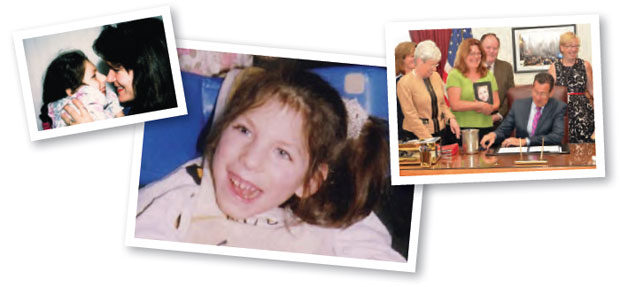Each time Lisa Avazian Saunders ’82 visited her severely disabled teenage daughter in the group home where the girl was being treated for life-threatening seizures, she knew it might be the last. She vividly recalls the winter morning in 2006 that proved to be their final goodbye: how she held Elizabeths face in her hands, exhorted her to “Be a good girl today,” strapped her fifty-pound body into the wheelchair, and kissed her. Elizabeth passed away that night.
Lisa and her husband, Jim Saunders ’81, had experienced a parallel loss sixteen years earlier, when they realized that their child would never lead a normal life. When Elizabeth was born in December 1989, her parents immediately knew that something was wrong: her head was distinctly undersized, so small that they feared she didn’t have a brain. She was taken away for testing, and doctors confirmed that Lisa had contracted cytomegalovirus (CMV) while pregnant, and had passed it on to her daughter.

Photos provided
CMV can often cause hearing loss, lack of coordination, and learning disabilities, but Elizabeth’s case was especially severe. The doctors said she’d stay at the mental and developmental level of a three-month-old her entire life; she’d never be able to walk, talk, or feed herself. “They kept pouring it on,” Jim recalls. “It was too much.” And then came the news that disturbed Lisa most of all: this nightmare likely could have been prevented.
Lisa learned that most people contract CMV at some point during their lifetime but display no symptoms; up to 80 percent of Americans carry the virus by age forty. However, when expectant mothers contract it and pass it to their fetus, it often results in permanent disabilities — as is the case for some 5,000 babies born in the U.S. each year. Young children are the most common vectors for CMV, which is transferred through body fluids. Pregnant women can significantly reduce their chances of contracting it by following simple hygiene practices including avoiding kissing toddlers on the mouth and washing hands often, especially after changing diapers or touching toys.
Why wasn’t I given this information before it was too late for me to do anything about it?
While Lisa was pregnant, she’d been running an in-home daycare center, interacting not only with her own three-year-old daughter, Jackie, but many other toddlers as well. “Why wasn’t I given this information before it was too late for me to do anything about it?” Lisa wondered. “Why didn’t my ob/gyn warn me?”
Over the next decade, Lisa stayed home with Elizabeth while Jim, a former nutritional sciences major, went to work as a scientist for pharmaceutical giant Pfizer. They suffered alongside Elizabeth as she endured chronic pneumonia, high fevers, intensive surgeries, and sleepless nights with painful muscle cramps due to cerebral palsy. “But when she was feeling good she was happy,” Jim says. “She could have the worst night and then in the morning she’d be all cheerful and smiling again.” When Elizabeth would hold her head up, even if it was just for a few seconds, they were euphoric. “Despite everything, she was a truly happy individual,” Lisa recalls, “and her joy was infectious.”
After Elizabeth’s death, Lisa and Jim realized that over the years that they’d been caring for her, awareness of CMV — and, more importantly, how to avoid catching it — had made little progress. Women were still giving birth to children disabled by this common virus — and they, too, were wondering why they hadn’t been warned.
That’s when Lisa, a former business management and marketing major, decided to take action. In 2009, she published a book entitled Anything But a Dog! The Perfect Pet for a Girl with Congenital CMV, in which she educates the public about the virus through a comical tale about the family’s efforts to find an animal that Elizabeth could tolerate. (They wound up with a Lab mix.) Lisa wrote stories in local papers, gave talks to groups like the Connecticut Nursing Association, and appeared on television, but she still worried she wasn’t getting the message out. “Pockets of people would learn about it, but there was no long-term effect,” she recalls. “It didn’t change anything.” Then in 2013, she learned of a bill passed in Utah that mandated CMV prevention education and required babies who failed hearing screenings be tested for the virus.
Determined to have a similar bill passed in Connecticut, Lisa gave herself a crash course in the legislative process, starting off at the only government office she was familiar with — the clerk where she’d licensed the family dog. She ultimately went to work lobbying her representatives about the importance of CMV testing and prevention. Last May, thanks in no small part to her efforts, the governor signed a bill requiring newborns who fail a hearing test to be screened for CMV so treatment can be administered sooner in the hope of ameliorating disabilities. Lisa notes that since the law was passed, state-wide interest in CMV has skyrocketed — and she remains hopeful that the attention will lead to legislation mandating prevention education. “Elizabeth will never have descendants,” Lisa writes in her book, “but perhaps through her story, future children will be born healthy because their mothers learned about how to avoid CMV.”


